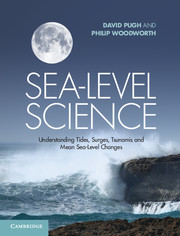Book contents
- Frontmatter
- Contents
- Preface
- List of acronyms
- List of main symbols
- Chapter 1 Introduction
- Chapter 2 Sea-level measuring systems
- Chapter 3 Tidal forces
- Chapter 4 Tidal analysis and prediction
- Chapter 5 Tidal dynamics
- Chapter 6 Shallow-water and coastal tides
- Chapter 7 Storm surges, meteotsunamis and other meteorological effects on sea level
- Chapter 8 Tsunamis
- Chapter 9 Spatial variations in sea level
- Chapter 10 Mean sea-level changes in time
- Chapter 11 Sea-level changes in time to do with the solid Earth
- Chapter 12 Sea-level applications
- Chapter 13 Sea level and life
- Appendix A Basic hydrostatic and hydrodynamic equations
- Appendix B Currents
- Appendix C High and low water times and heights from harmonic constituents
- Appendix D Theoretical tidal dynamics
- Appendix E Legal definitions in the coastal zone
- Glossary
- Index
- References
Chapter 2 - Sea-level measuring systems
Published online by Cambridge University Press: 05 May 2014
- Frontmatter
- Contents
- Preface
- List of acronyms
- List of main symbols
- Chapter 1 Introduction
- Chapter 2 Sea-level measuring systems
- Chapter 3 Tidal forces
- Chapter 4 Tidal analysis and prediction
- Chapter 5 Tidal dynamics
- Chapter 6 Shallow-water and coastal tides
- Chapter 7 Storm surges, meteotsunamis and other meteorological effects on sea level
- Chapter 8 Tsunamis
- Chapter 9 Spatial variations in sea level
- Chapter 10 Mean sea-level changes in time
- Chapter 11 Sea-level changes in time to do with the solid Earth
- Chapter 12 Sea-level applications
- Chapter 13 Sea level and life
- Appendix A Basic hydrostatic and hydrodynamic equations
- Appendix B Currents
- Appendix C High and low water times and heights from harmonic constituents
- Appendix D Theoretical tidal dynamics
- Appendix E Legal definitions in the coastal zone
- Glossary
- Index
- References
Summary
When you can measure what you are speaking about, and express it in numbers, you know something about it.
Lord KelvinThe science of measurement
The ocean is its own uncontrollable laboratory and the oceanographer who measures the properties of the sea is an observational rather than an experimental scientist. Sea levels can be measured in situ, or by altimetry-satellite remote sensing. Technically the necessity of making in situ measurements of sea level presents many challenges in terms of the logistics of travel to the site, for deployment of the equipment, and for its safe and reliable operation in a frequently hostile environment.
This chapter summarises methods of measuring changes of sea levels over tidal and longer periods. The special requirements of tsunami monitoring are further discussed in Chapter 8. Measurements of currents are not included here (but see Section 4.4 on analyses of currents) as they are covered in many general oceanographic textbooks. Measurements of sea level by satellite altimetry, which are closely linked to orbit computations, mean sea level (MSL), and the shape of the Earth, are discussed extensively in Chapter 9.
- Type
- Chapter
- Information
- Sea-Level ScienceUnderstanding Tides, Surges, Tsunamis and Mean Sea-Level Changes, pp. 17 - 35Publisher: Cambridge University PressPrint publication year: 2014



